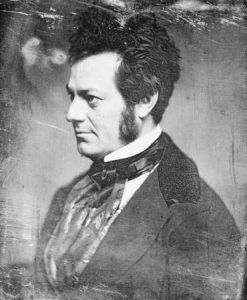Who is Edwin Forrest?

In the early 1800s, Americans flocked to theaters as a source of entertainment and drama. During this time, American actors began to challenge the dominance of British actors and theater. One of these actors, Edwin Forrest of Philadelphia, would become one of the most well-known and popular performers of the first half of the nineteenth century.
Born on March 9, 1806 in Philadelphia, Forrest joined his first theater company at the age of twelve. In 1820 at the age of fourteen, Forrest made his professional debut at the Walnut Street Theatre in Philadelphia. For several years, he traveled to Cincinnati, Louisville, and other towns in what was then known as “the West” before making his debut in New York City in July 1826 in Othello. Although that performance was not well-received, a performance at the Bowery Theatre in November in the same role was so successful that Forrest became the leading attraction for the remainder of the season.
Over the next twenty years, Forrest became known and admired as a talented and popular actor. Both a Shakespearean actor and a supporter of emerging American playwrights, his roles included Spartacus, Macbeth, Hamlet, and Metamora in Metamora; or, The Last of the Wampanoags.
Forrest continued to appear in plays and perform readings during the 1850s and 1860s. In 1855, Forrest purchased a stone mansion at 1346 North Broad Street in Philadelphia. Three and a half stories tall and built in the Italianate architectural style, the house included Forrest’s extensive library and a courtyard with a fountain. A gallery attached to the house provided space for Forrest’s art collection as well as a private theater with a small stage.
Forrest died at his Broad Street home in Philadelphia on December 12, 1872. In his will, he left much of his estate for the formation and maintenance of the Edwin Forrest Home, a residence where elderly actors could live and receive medical attention for no cost. The home initially opened at Springbrook, Forrest’s country residence in the Holmesburg area of North Philadelphia, in 1876. In the 1920s, the home moved briefly to a mansion in Torresdale before relocating to a facility at 4849 Parkside Avenue near Fairmount Park in 1928. The home remained in existence at that location until 1986 when it merged with the Lillian Booth Actors’ Home of the Actors’ Fund of America in Englewood, New Jersey. A wing at the Lillian Booth Home is named in honor of Edwin Forrest.
After Forrest’s death, his home on Broad Street remained vacant until 1880 when it was purchased by the Philadelphia School of Design for Women. In the 1960s, it became the location of Heritage House, a community center for young adults, before becoming the home of the Freedom Theatre, Pennsylvania’s oldest African-American theater founded in 1966. Freedom Theatre continues to offer classes and performances in the former Edwin Forrest House.
In Philadelphia, Forrest and his contributions to American theater are remembered in a variety of ways. The Forrest Theatre at 1114 Walnut Street is named after the actor as is the Edwin Forrest Elementary School at 7300 Cottage Street. In 1990, the Walnut Street Theatre established the Edwin Forrest Award recognizing an individual or organization’s significant contributions to American theater. On March 9, 2006, Philadelphia celebrated Forrest’s 200th birthday by declaring March 9 “Edwin Forrest Day” and collecting donations at local theaters for the Lillian Booth Actors’ Home of the Actors’ Fund of America.
